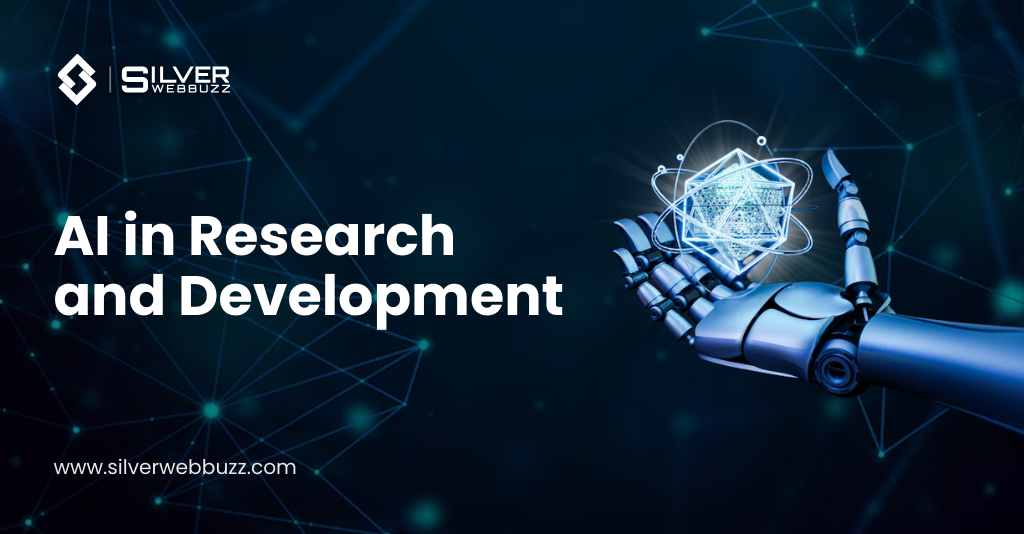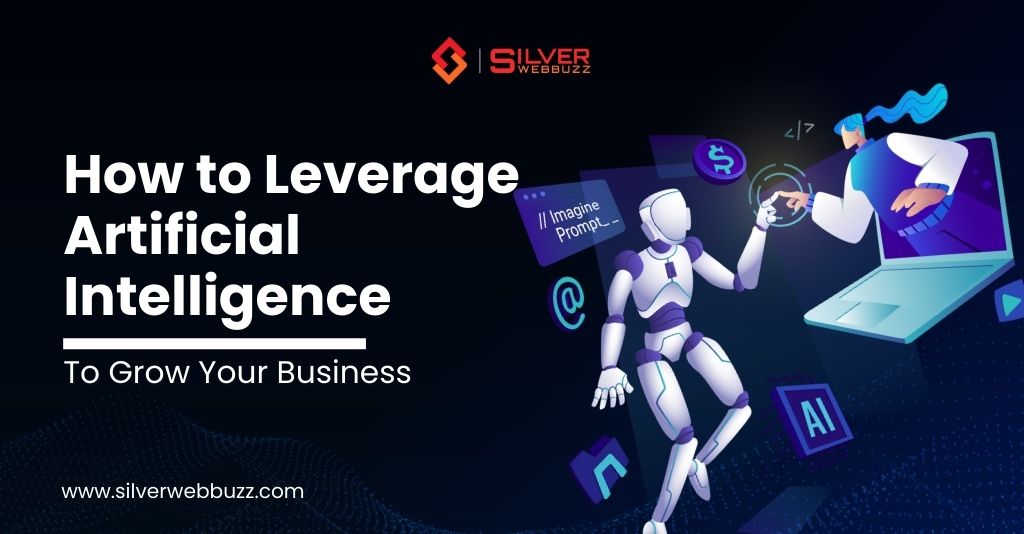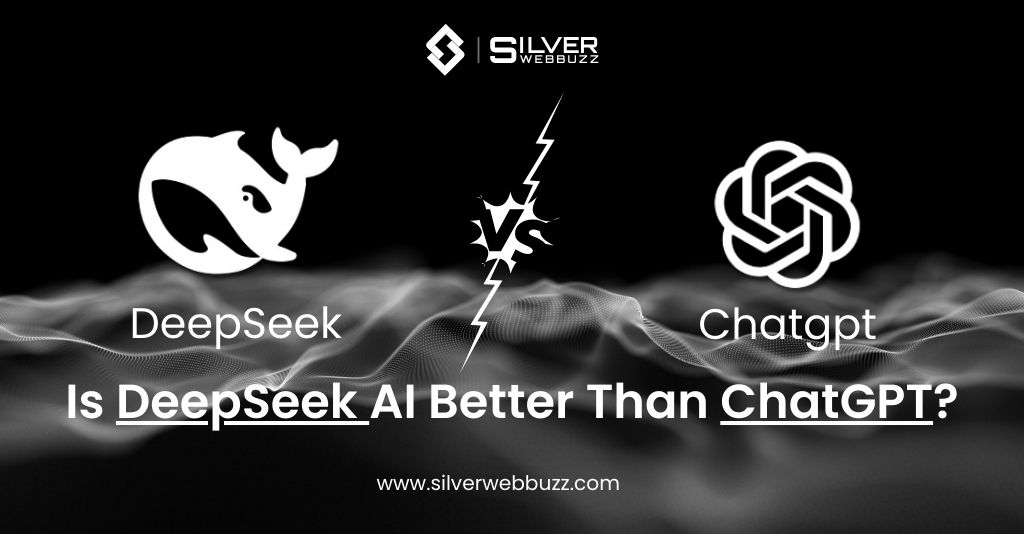Overview of AI’s Growing Role in Research and Development (R&D)
AI in Research and Development known as Artificial Intelligence (AI) is transforming Research and Development (R&D) by enhancing innovation, automating processes, and accelerating discoveries. From pharmaceuticals to engineering, AI is enabling faster, data-driven insights and helping researchers tackle complex challenges with greater efficiency.
How AI is Accelerating Innovation Across Industries?
AI-powered algorithms analyze massive datasets, identify patterns, and make accurate predictions, significantly reducing the time required for experimentation. It is helping businesses and researchers optimize resources, minimize risks, and explore new frontiers in science, technology, and product development.
Key Benefits of AI-Driven R&D
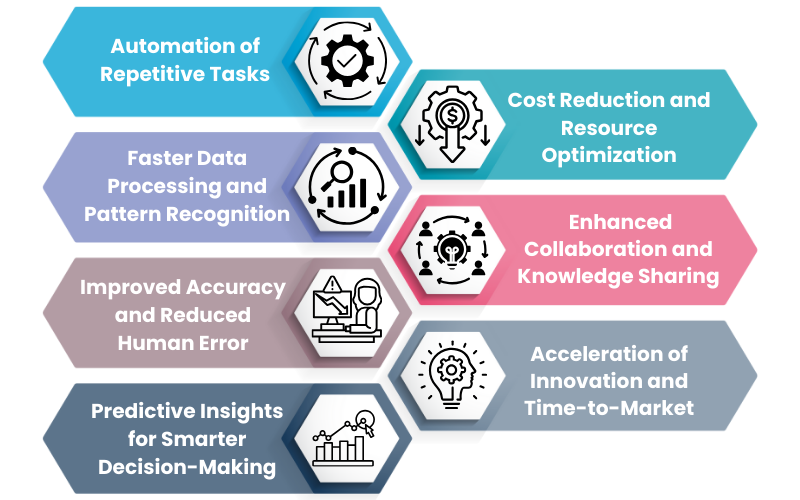
AI offers several advantages in Research and Development (R&D), enabling automation, improved accuracy, and data-driven insights. By integrating AI, companies can optimize workflows, reduce costs, enhance decision-making, and accelerate innovation. Here are the key benefits of AI-driven R&D:
1. Automation of Repetitive Tasks
AI automates time-consuming research activities such as data collection, literature reviews, and preliminary analysis. This frees up researchers to focus on complex problem-solving and innovation rather than manual, repetitive work.
2. Faster Data Processing and Pattern Recognition
AI-powered systems analyze large datasets much faster than human researchers. Machine learning models can identify hidden patterns, correlations, and trends, leading to more accurate research outcomes and faster discoveries.
3. Improved Accuracy and Reduced Human Error
AI eliminates biases and errors associated with manual data processing, ensuring high accuracy in research findings. AI-driven simulations and automated testing help refine results, reducing costly mistakes in the R&D process.
4. Predictive Insights for Smarter Decision-Making
AI enables predictive modeling, helping researchers anticipate future trends, market demands, and technological advancements. These insights guide businesses in making informed investment decisions and optimizing R&D strategies.
5. Cost Reduction and Resource Optimization
AI minimizes waste by streamlining R&D workflows, reducing trial-and-error experiments, and optimizing material and resource usage. Companies can significantly lower research costs while improving efficiency.
6. Enhanced Collaboration and Knowledge Sharing
AI-driven collaboration tools allow researchers across different locations to work together seamlessly. AI-powered platforms help manage research documents, generate insights, and facilitate real-time knowledge exchange.
7. Acceleration of Innovation and Time-to-Market
AI speeds up the development and testing phases of new products, enabling businesses to launch innovations faster. This competitive advantage allows companies to stay ahead in technology-driven industries.
The Impact of AI on Research and Development

Enhancing Data Analysis and Pattern Recognition
AI enables researchers to process and analyze vast amounts of data at an unprecedented speed. Machine learning algorithms can detect patterns, correlations, and anomalies that human researchers might miss, leading to groundbreaking discoveries and advancements.
Automating Repetitive Research Tasks
Many research tasks, such as literature reviews, data collection, and hypothesis testing, can be automated using AI. This reduces manual efforts, allowing scientists and engineers to focus on high-value problem-solving and innovation.
Enabling Faster Decision-Making with AI-Powered Insights
AI models provide predictive insights that help researchers make data-backed decisions quickly. By simulating various scenarios, AI reduces uncertainty, enhances precision, and supports real-time decision-making in R&D projects.
AI’s Role in Reducing R&D Costs and Risks
AI minimizes trial-and-error experiments, streamlining the research process and reducing development costs. AI-driven simulations and digital twins allow businesses to test concepts virtually before physical implementation, lowering the risk of costly failures.
AI Use Cases in Research and Development: How AI is Transforming Industries
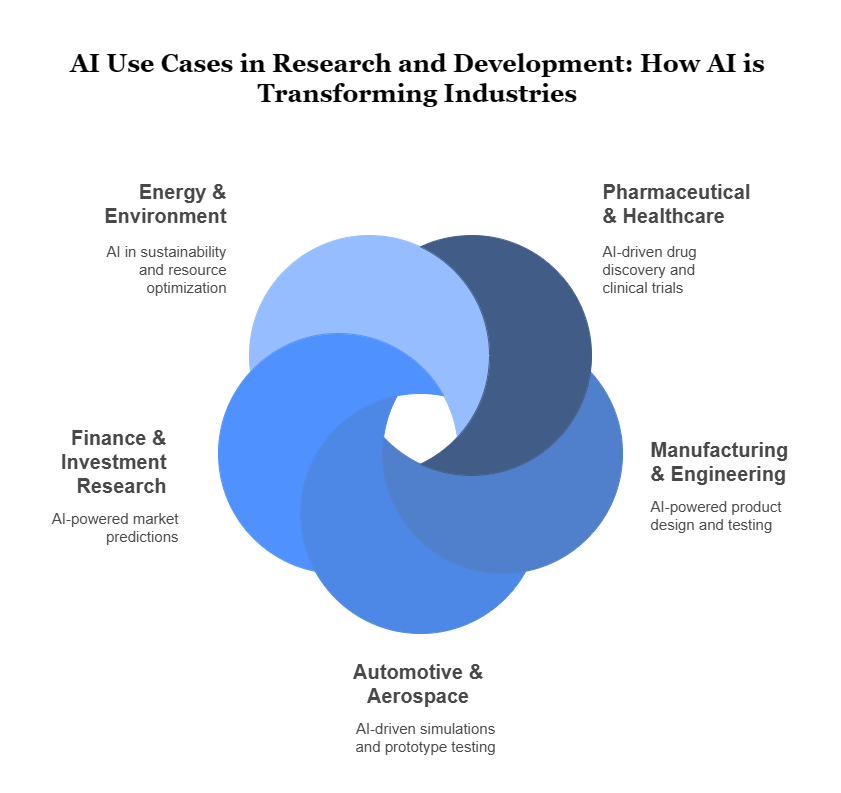
Pharmaceutical & Healthcare – AI-Driven Drug Discovery and Clinical Trials
AI is revolutionizing drug discovery by analyzing biological data, identifying potential drug candidates, and predicting their effectiveness. AI models also optimize clinical trial processes, selecting suitable participants and reducing the time needed to bring new drugs to market.
Manufacturing & Engineering – AI-Powered Product Design and Testing
AI enhances manufacturing R&D by optimizing product design, improving material selection, and predicting product performance. AI-driven simulations help engineers identify design flaws early, reducing prototyping costs and improving efficiency.
Automotive & Aerospace – AI-Driven Simulations and Prototype Testing
AI is crucial in vehicle and aircraft development, enabling automated simulations of aerodynamics, material durability, and safety features. Autonomous driving and flight simulations powered by AI are accelerating advancements in mobility and transportation.
Finance & Investment Research – AI-Powered Market Predictions
Financial firms leverage AI for risk assessment, portfolio management, and investment research. AI analyzes market trends, economic indicators, and historical data to make accurate predictions, improving investment strategies and reducing financial risks.
Energy & Environment – AI in Sustainability and Resource Optimization
AI is playing a key role in sustainability efforts by optimizing energy consumption, predicting climate patterns, and improving resource allocation. AI-powered solutions are helping companies in renewable energy, environmental conservation, and waste reduction.
How to Integrate AI in R&D
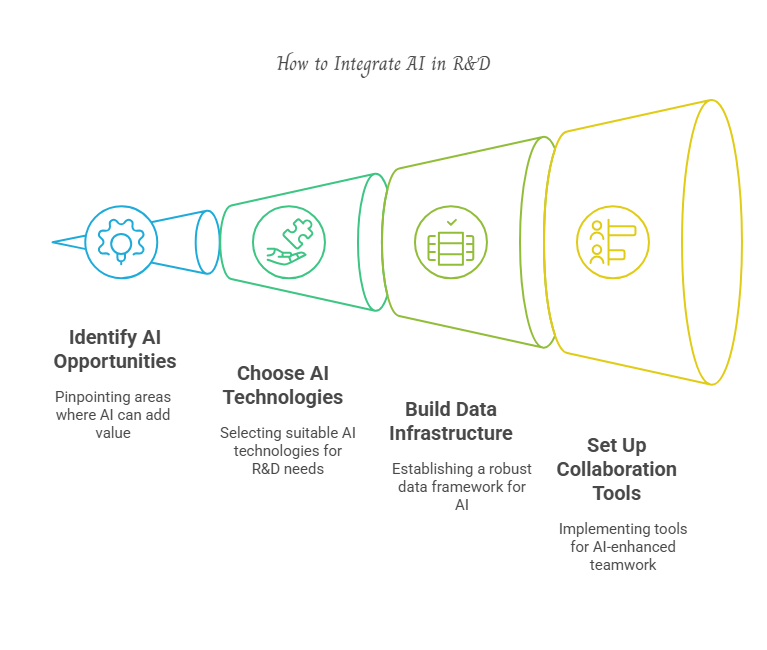
Identifying AI Opportunities in the R&D Workflow
Organizations must assess their existing R&D processes and identify areas where AI can enhance efficiency. This includes automating data processing, improving simulations, and leveraging AI for hypothesis testing and decision-making.
Choosing the Right AI Technologies (ML, NLP, Computer Vision, etc.)
Different AI technologies serve various R&D purposes. Machine Learning (ML) is useful for predictive modeling, Natural Language Processing (NLP) assists with automated research analysis, and Computer Vision aids in image recognition and quality control.
Building an AI-Ready Data Infrastructure
AI relies on high-quality data for accurate analysis. Establishing a robust data infrastructure involves collecting, organizing, and preprocessing data efficiently. Cloud-based AI platforms facilitate scalable and secure AI model training.
Setting Up AI-Driven Collaboration Tools
AI-powered collaboration tools improve teamwork in research environments. Virtual assistants, AI chatbots, and knowledge-sharing platforms enhance communication, streamline research documentation, and facilitate knowledge transfer between teams.
Steps to Implement AI in Research and Development
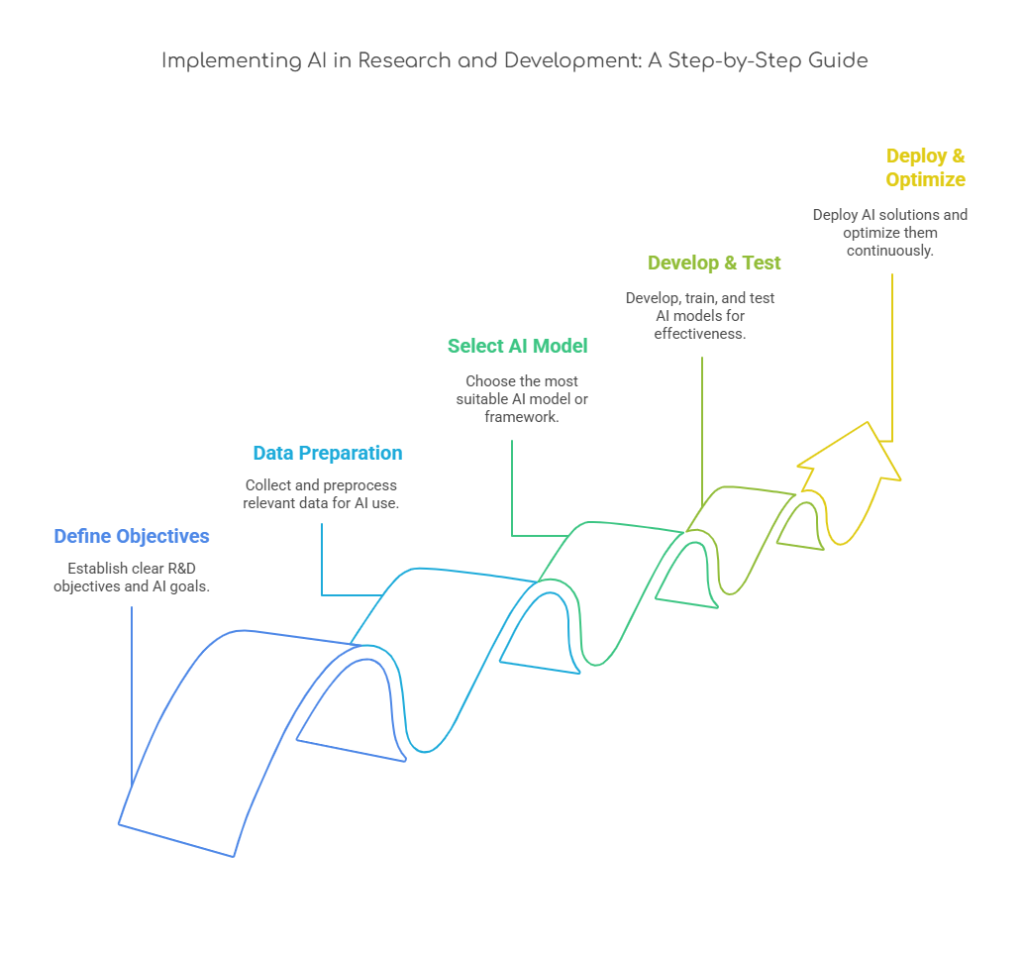
Successfully integrating AI into the Research and Development (R&D) process requires a structured approach. By following these steps, businesses and research institutions can ensure effective AI implementation, leading to enhanced efficiency, better insights, and accelerated innovation.
Step 1: Define R&D Objectives and AI Implementation Goals
Before integrating AI into R&D, it is essential to clearly outline the objectives and expectations. Identify whether AI will be used for automating repetitive research tasks, predictive modeling for future trends, advanced data analysis, or intelligent simulations. Setting clear AI implementation goals helps streamline resource allocation and ensures alignment with business and research needs.
Step 2: Gather and Preprocess Relevant Data
AI-driven R&D heavily relies on high-quality data for accurate predictions and meaningful insights. Organizations must collect both structured (numerical, categorical) and unstructured (text, images, videos) data relevant to the research domain. Data preprocessing, including cleaning, labeling, and removing inconsistencies, ensures that AI models are trained on high-quality datasets, improving their accuracy and reliability.
Step 3: Select the Appropriate AI Model or Framework
Choosing the right AI model is crucial for maximizing efficiency in R&D processes. Pre-trained AI models such as GPT (for text processing) or computer vision models (for image recognition) can be used for common tasks, reducing development time and costs. However, businesses requiring highly specialized AI functionalities may opt for custom AI solutions tailored to their specific research objectives, ensuring better performance and adaptability.
Step 4: Develop, Train, and Test AI Models
Once the AI model is selected, the next step involves developing and training it using high-quality datasets. The training phase involves feeding the AI system with relevant data, adjusting parameters, and optimizing performance to improve accuracy. Rigorous testing, including validation and real-world simulation, ensures that the AI model meets accuracy standards, eliminates biases, and aligns with the organization’s R&D goals before full deployment.
Step 5: Deploy AI Solutions and Continuously Optimize Them
After successful training and testing, AI solutions are deployed into the R&D workflow, integrating seamlessly with existing systems. Continuous monitoring is essential to assess the model’s effectiveness, identify areas for improvement, and ensure optimal performance. Regular updates, retraining with new data, and fine-tuning AI algorithms help maintain accuracy, adaptability, and relevance as research needs evolve over time.
Current Trends in AI for R&D

AI-Driven Automation and Robotics in Research Labs
AI-powered robots are assisting scientists in laboratory experiments, reducing human effort and increasing precision. Automated research systems enable large-scale data analysis and experimentation.
The Rise of Generative AI in Innovation and Creativity
Generative AI is being used to design new materials, create innovative product prototypes, and generate novel research hypotheses, pushing the boundaries of traditional R&D.
AI-Powered Predictive Analytics for R&D Decision-Making
AI models analyze past research data to predict future trends, helping companies make informed decisions regarding innovation and market strategies.
AI-Enhanced Collaboration Through Cloud-Based R&D Platforms
Cloud-based AI platforms facilitate global collaboration among researchers, enabling seamless knowledge-sharing, remote experimentation, and AI-driven data analysis.
Addressing AI Implementation Challenges in R&D

Data Privacy and Security Concerns
AI relies on sensitive research data, making data security a top priority. Implementing encryption, access controls, and compliance measures helps protect confidential information.
Ethical Considerations in AI-Driven Research
AI must be developed ethically to prevent biases and ensure fairness. Transparent AI decision-making processes and adherence to regulatory guidelines are essential for ethical R&D.
Integration Challenges with Existing R&D Workflows
Implementing AI into existing research processes requires technical expertise. Organizations must ensure seamless integration with legacy systems while maintaining efficiency.
Ensuring AI Model Accuracy and Reducing Biases
AI models must be continuously validated to avoid biases and inaccuracies. Regular audits, diverse datasets, and human oversight improve AI reliability in research applications.
How to Leverage Artificial Intelligence to Grow Your Business
How SilverWebBuzz’s Custom AI Solutions Help Achieve R&D Excellence.
Overview of SilverWebBuzz’s AI-Driven Solutions for Research & Development
SilverWebBuzz provides customized AI solutions designed to enhance R&D efficiency. Their AI expertise spans industries, from healthcare and finance to manufacturing and sustainability.
Tailored AI Solutions for Different Industries
SilverWebBuzz delivers AI-powered tools tailored to industry-specific R&D needs. Their solutions streamline research workflows, enhance automation, and improve predictive modeling.
Case Studies of Successful AI Implementation in R&D
The company has successfully implemented AI solutions for various organizations, improving research accuracy, reducing costs, and accelerating innovation timelines.
How SilverWebBuzz Optimizes R&D Efficiency and Innovation
With advanced AI strategies and scalable solutions, SilverWebBuzz empowers businesses to optimize their R&D processes, ensuring continuous growth and competitive advantage.
Conclusion
AI is set to revolutionize R&D by enhancing research capabilities, accelerating discoveries, and enabling data-driven decision-making. The future of AI-driven research holds immense potential for groundbreaking innovations. Adopting AI in R&D enhances efficiency, reduces costs, and provides a competitive edge. Companies investing in AI-driven research today will lead tomorrow’s innovation landscape. Partner with SilverWebBuzz to integrate AI into your R&D process and unlock new possibilities for innovation and discovery. Contact us today for expert AI solutions!
